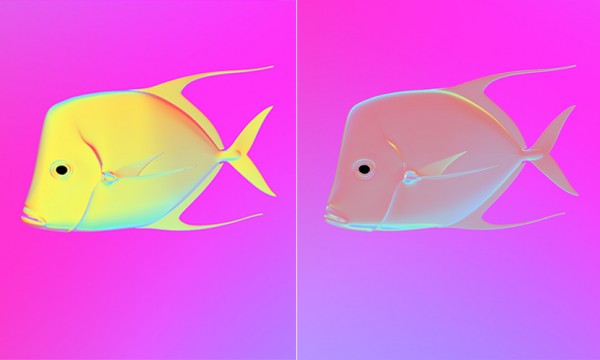How Fish Can Turn Invisible Underwater
| Ana Verayo | | Nov 24, 2015 08:12 AM EST |
(Photo : Cummings Lab/University of Texas) Simulated view of how the lookdown fish would appear in polarized light with mirrored skin (left) versus skin that reflects polarized light (right).
Some fish species apparently possess light altering properties, making them appear invisible underwater. Scientists discovered that some fish have skin cells with microscopic structures that enable them to release polarized light, using this strategy as a stealth mode to escape from predators.
Like Us on Facebook
For humans, the underwater environment in oceans could appear unchanging, however marine animals see the ocean in diverse views, as the environment creates optical illusions, similar to a kaleidoscope effect. This special ability allows certain fish to camouflage themselves and evade predators as a means for survival.
In this new study, scientists Molly Cummings and Parrish Brady of the University of Texas examined and investigated how fish can adjust to fluctuations in polarized lighting in underwater conditions.
Researchers say that vibrations are sent from polarizing light waves as long as they are both travelling on the same level. However, most light under the oceans are not polarized and produce vibrations, as they are all travelling on different planes.
Light before it hits the water is not polarized and once it enters the ocean, sunlight can then create a sparkling shimmery effect with reflection. In underwater conditions, sunlight now becomes polarized. Some fish with skin cells that have platelets can now identify and mimic these vibrations coming from the polarized lights.
These fish platelets are made up of small nanoscale crystals, making them shiny, glimmering underwater. This new study reveals how these shiny, luminous scales of the fish are crucial to fish survival.
According to Brady, the platelets are arranged in a specific pattern that they scatter reflecting light away from the animal, emitting a silver sheen when someone looks at the fish. They are also aligned this way to produce reflective properties.
With these new findings, special reflective fish platelets can lead to the development of military optics, for human camouflage applications especially in underwater environments. This new study is published in the journal, Science.
Tagshow fish become invisible underwater, invisible fish, fish invisible polarized light, fish platelets structures invisible, fish skin invisible underwater camouflage, fish camouflage, fish invisibility
©2015 Chinatopix All rights reserved. Do not reproduce without permission
EDITOR'S PICKS
-

Did the Trump administration just announce plans for a trade war with ‘hostile’ China and Russia?
-

US Senate passes Taiwan travel bill slammed by China
-

As Yan Sihong’s family grieves, here are other Chinese students who went missing abroad. Some have never been found
-

Beijing blasts Western critics who ‘smear China’ with the term sharp power
-

China Envoy Seeks to Defuse Tensions With U.S. as a Trade War Brews
-

Singapore's Deputy PM Provides Bitcoin Vote of Confidence Amid China's Blanket Bans
-

China warns investors over risks in overseas virtual currency trading
-

Chinese government most trustworthy: survey
-

Kashima Antlers On Course For Back-To-Back Titles
MOST POPULAR
LATEST NEWS
Zhou Yongkang: China's Former Security Chief Sentenced to Life in Prison

China's former Chief of the Ministry of Public Security, Zhou Yongkang, has been given a life sentence after he was found guilty of abusing his office, bribery and deliberately ... Full Article
TRENDING STORY

China Pork Prices Expected to Stabilize As The Supplies Recover

Elephone P9000 Smartphone is now on Sale on Amazon India

There's a Big Chance Cliffhangers Won't Still Be Resolved When Grey's Anatomy Season 13 Returns

Supreme Court Ruled on Samsung vs Apple Dispute for Patent Infringement

Microsoft Surface Pro 5 Rumors and Release Date: What is the Latest?










